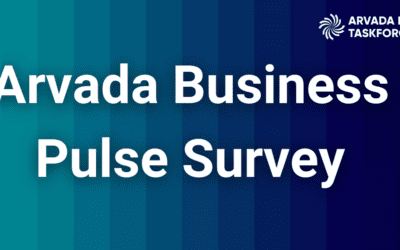
This resource is supported by The Arvada Resiliency Taskforce.
[su_row][su_column size=”1/2″ center=”no” class=””]
On September 9, a presidential announcement required employers with 100 or more employees to mandate that their workers be vaccinated or undergo weekly testing. The Occupational Safety and Health Administration (OSHA) released on November 5 its rules specifying how businesses with at least 100 employees are to ensure their employees are vaccinated against COVID-19, and how to implement an option for employees to be tested if they do not want to be vaccinated.
The rules, known as an Emergency Temporary Standard (ETS) and enforceable by law, require these large businesses to ensure that their workers are vaccinated by January 4. After that, if the employer chooses, employees can avoid vaccination by submitting a weekly negative test for COVID-19. Under the ETS, employers must give employees paid time off to get immunized or to recover from any side effects. Workers must provide proof of vaccination to their employer, which is required to maintain records of vaccination status and test results for all employees.
[/su_column]
[su_column size=”1/2″ center=”no” class=””]
[su_icon_panel background=”#3D5C9B” color=”#ffffff” shadow=”0px 1px 2px #eeeeee” icon=”icon: file-o” icon_color=”#ffffff” target=”blank”]RESOURCES
- OSHA: Vaccine Mandate FAQ
- U.S. Chamber: FAQ for Businesses
- OSHA Fact Sheet: Workers Rights Under the Vaccine
- State of Colorado: Vaccine Laws and Regulations
- SHRM: Tracking Tools to Help HR Comply
[su_spacer size=”10″]
[/su_icon_panel]
[/su_column][/su_row]
Unvaccinated employees are required to wear a mask in the workplace starting on December 5, if they aren’t already required to do so by their employer. Businesses that don’t comply with the requirements could face fines in excess of $13,000 per violation.
Below are frequently asked questions about this mandate, complied by OSHA and the U.S. Chamber of Commerce.
How did OSHA arrive at the 100-employee threshold?
According to the ETS, the agency feels that businesses with at least 100 employees have the capacity to carry out the vaccine mandates without undue administrative or financial burden. Based on the 100-employee threshold, the ETS will impact two-thirds of all private-sector workers in the U.S. OSHA feels implementing the mandates in businesses with less than 100 employees would cause “undue disruption.” However, the agency is still looking into the matter and is seeking comment on whether the rule should apply to smaller businesses.
How are the 100 employees counted?
For starters, the threshold is per company, not per location. So, for instance, a franchise operator with one store that has less than 100 employees isn’t covered under the ETS. But a franchise operator with three stores and more than 100 employees total among those stores is subject to the ETS. Similarly, a business is subject to the ETS if it has at least 100 employees at any time during the six-month period in which the ETS is in effect, even if its workforce falls below 100 during that timeframe.
Are part-time employees included in the 100-employee threshold?
Yes. Part-time employees do count towards the total number of employees. For example, a company with 75 part-time employees and 25 full-time employees would be considered to have 100 employees and would be within the scope of this standard. Independent contractors do not count towards the total number of employees.
What qualifies as being fully vaccinated?
OSHA considers an employee fully vaccinated if they have had both doses of the Pfizer or Moderna vaccination or one dose of the Johnson & Johnson vaccination. Those employees who have received only one shot of the Pfizer or Moderna vaccination are not considered fully vaccinated. Neither are those employees who have previously had COVID and recovered. Booster shots are not part of the vaccination requirement under the ETS.
Do I need to pay for vaccines and testing?
Employers do not have to pay for vaccinations (they are available for free) but must provide up to four hours of paid leave for workers to receive each vaccination dose. This leave cannot take from the employees’ existing paid leave balance. Employers must also provide time off to recover, with OSHA suggesting up to two days, and those two days can be drawn from existing paid leave balances. Moreover, employers do not have to provide paid time off for employees who test positive and must be removed from the workplace.
Employers do not have to provide tests or pay for them if an employee merely refuses to be vaccinated. However, if an employee has a religious or medical exemption, the employer would have to pay for testing. The ETS specifies what types of tests are acceptable.
What are the key compliance dates under the ETS?
The effective date for the ETS is November 5, 2021, which is the date the ETS was published in the Federal Register. Although the ETS becomes effective immediately, employers have some time to come into compliance with the different requirements of the ETS.
By December 5, employers will have to:
- Conduct an assessment of their workforce to determine who is vaccinated and who is not, obtain acceptable proof of vaccination, and maintain records and roster of vaccination status
- Establish their policy on vaccination
- Ensure employees who are not fully vaccinated wear proper face coverings when indoors or in a vehicle with another person for work purposes
- Provide each employee information about the ETS, workplace policies and procedures, vaccination efficacy, safety and benefits, protections against retaliation and discrimination, and laws that provide for criminal penalties for knowingly supplying false documentation
- Report work-related COVID-19 fatalities within 8 hours and work-related COVID-19 in patient hospitalizations within 24 hours
- Remove any employee who received a positive COVID-19 test or COVID-19 diagnosis.
By January 4, employers will have to:
- Ensure all employees are fully vaccinated, or ensure employees who are not fully vaccinated are tested for COVID-19 at least weekly, or within 7 days before returning to work if away from the workplace for a week or longer.



0 Comments